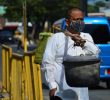Cayog, who is also chairman of Kalumaran, an alliance of Lumads in Mindanao, said projects like these would use their land at the expense of the Lumads’ survival. They depend on these lands for farming and hunting. Their way of life, their culture and tradition, revolve around these ancestral lands.
This is also true of other projects such as plantation expansion, said Dulphing Ogan, a B’laan from Sultan Kudarat and secretary general of Kalumaran.
In her recent State of the Nation Address, President Gloria Macapagal-Arroyo stressed the development of Mindanao’s economy, which includes the expansion of agri-business and power projects. The agri-business industry includes conversion of farms to pineapple, palm oil and banana plantations, said Ogan. This is already happening in many parts of Mindanao, including Socsksargen, Bukidnon, and Compostela Valley.
Ogan, however, thinks that this industry only benefits the export business and its companies, and not the farmers and Lumads. “We cannot eat the pineapples,” Ogan said. “How are we going to have rice and corn when our farms are being converted for export crops?”
Mindanao contributes massively to the country’s agriculture production, providing, for example, 50 percent of the national rice and corn output. But this production will be severely affected not only with the expansion of plantations but with the entry of large-scale mining companies as well, most of them foreign-owned. The government is targeting 10 mining priority areas in Mindanao, most of which are in Lumad lands.
In Siocon, Zamboanga del Norte, the Canadian mining firm Toronto Ventures have ravaged Mount Canatuan, the sacred ground of the Subanen tribe, according to environmentalists. Already, Toronto Ventures is eyeing expansion into nearby provinces.
The expansion of industries has its price, environmental degradation one of them. The Save Siocon Paradise Movement, which is composed of peasants and Subanen communities, have sounded the alarm that toxic wastes are seeping into the rivers and irrigation of their ricefields. The Zamboanga region, according to the group, relies on Siocon for a a good portion of its rice output.
The group also reported that a sulfide dam has collapsed for the second time last month, leaving one person dead.
Not even the Indigenous People’s Reform Act (IPRA), a law aimed to safeguard the indigenous communities, could protect the Lumads from the companies, according to Cayog.
He accused the National Commission for the Indigenous Peoples (NCIP), a creation of the IPRA, for practically handing over the Certificate of Ancestral Domain Titles (CADT) of Lumads into the hands of these big companies. He cited the case of the B’laan community in Tampakan, South Cotabato, where Sagittarius Mines Inc. acquired the CADT from the tribal leaders.
With the insititutions of government failing them, the Lumads have to fend for themselves. But Ogan said that when Lumads protest, the military comes in to protect the companies. These often lead to human rights abuses.
Military operations also occur frequently in communities that resist development projects, as in the case of Ogan’s community that is opposing Sagittarius Mines. And the military always allege that the New People’s Army is responsible for the opposition to the mining projects, accusing the communists of influencing the Lumad’s resistance. This, in turn, justifies more abuses by the military, according to human rights groups.
The Indigenous Peoples Human Rights Watch notes that 61 of the 129 indigenous people killed under Arroyo’s regime are Lumads from Mindanao, including children and minors. Most of these are victims of military operations, paramilitary groups, and military-created death squads, Cayog said.
But he said these will not deter the Lumads from resisting. �For us, our land is our life,� Cayog said. (Tyrone A. Velez and Cheryll D. Fiel/davaotoday.com)
Indigenous Peoples









